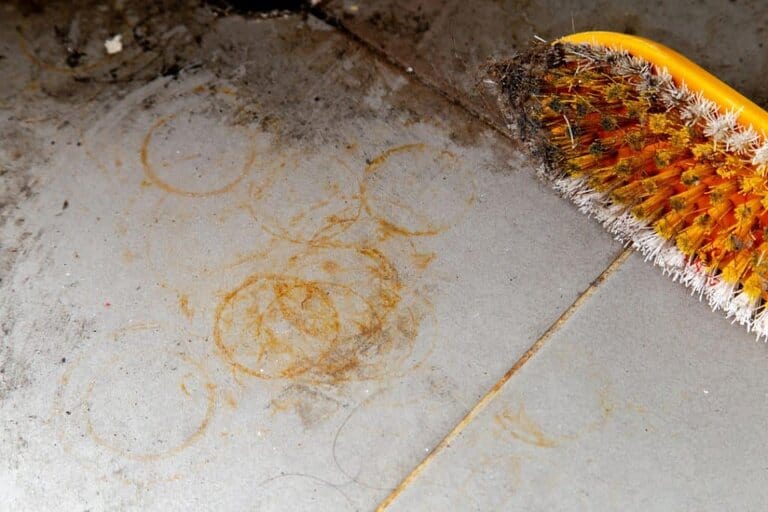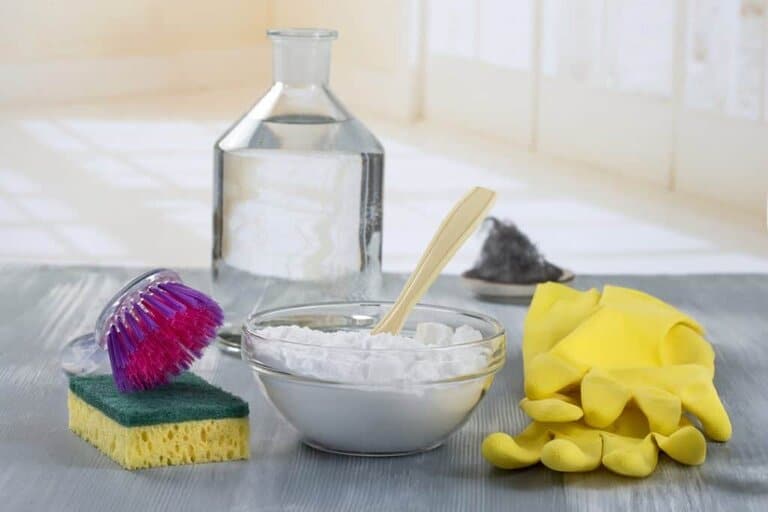You can remove rust from linoleum with the help of homemade DIY hacks using vinegar, lemon juice, and cream of tartar. You can use chemical cleaners as well, but you have to be meticulous about their selection. Remember, prevention is better than cure – take proper care of your linoleum floor to prevent rust stains in the first place!

We all love beautiful homes and offices that look pleasing to the eye. One way of having gorgeous places to live and work is by installing alluring flooring in these places, such as vinyl or linoleum flooring. However, at times, our artistic flooring tends to get rusted up in some places.
If you have linoleum flooring, you can get away with a lot of stains and spills since linoleum is pretty resistant to stains – this is the major reason for its popularity in kitchens. Unfortunately, there are a lot of pretty stubborn stains and you can’t simply get rid of them using paper towels and good ol’ soap – such as dreaded rust.
The million-dollar question then becomes: How to remove rust stains from linoleum flooring? This is what we are here for. We will tell you all you need to know about removing the horrendous rust stains dimming the beauty of your elegant floors!
Without further ado, let’s get started!
Even though linoleum flooring is durable, it still gets stained, particularly when it comes to rust. The trick is to remove the rust stains as soon as you see them, and not when it is already too late to save your beautiful floors.
Three Homemade DIY Methods to Remove Rust from Linoleum
From the legs of metal furniture to various appliances in your home, it is very easy to cause rust accidentally. Even if you simply leave something metallic on the floor on a very hot, humid day, it can result in rust.
You might be wondering: Will I have to buy an expensive cleaner or spend hundreds on a professional fix? Lucky for you, we have some homemade DIY hacks right here for you before you call anyone or spend your hard-earned money on some fancy cleaner.
Use Vinegar and Bicarbonate

Supplies Required
- Bowl
- Water
- Non-Abrasive Clean Cloth
- Vinegar
- Bicarbonate
- Towels
- Rubbing Alcohol
Method
- Move away from any obstacles, such as furniture, appliances, etc.
- Clean the affected area thoroughly. This will not only remove grime or grease from the floor so that you can focus on the stain only but will also ensure that nothing else interacts with the cleaning ingredients that you are using.
- If you have recently waxed your floors, you will have to clear it away since it will create a water-resistant layer that will render your hard work useless.
- Place towels in the surrounding area so that you don’t create a mess while cleaning the stains.
- Cover the rust stain with an even layer of baking soda and let it sit for a few minutes.
- Dampen the clean cloth with vinegar.
- Rub the spot thoroughly with the cloth. The mixture will fizz and hiss as the baking soda reacts with the vinegar.
- Put some water in the bowl and use it to rinse the area.
- Repeat the process until the bicarb and vinegar successfully oxidize the rust stain, successfully removing the eyesore!
- If the method is working, but the stain is not lifting on completely, you can wipe the area with rubbing alcohol in the beginning.
Using Lemon Juice
Supplies Required
- Lemon Juice
- Vinegar
- Baking Soda
- Towel
- Brush
- Water
Method
- Apply lemon juice to the affected area.
- Let it sit for 15 minutes.
- With the help of a soft brush, scrub the spot thoroughly.
- Rinse with water.
- Repeat until you get the desired results.
- For better results, you can mix vinegar with lemon juice in a 50/50 ratio.
- You can make a paste with lemon and baking soda as well. Simply cover the surface with baking soda and add lemon juice to create a paste. Scrub until the stain is no more.
Using Cream of Tartar
Supplies Required
- Cream of Tartar
- Water
- Cloth/Towel
Method
- Take some cream of tartar and mix it with water until you create a thick paste.
- Apply the paste onto the stains.
- Let it sit for 10 minutes.
- Scrub the stains thoroughly with the towel.
- Rinse the site with clean water.
- If the stain is still there, repeat the process.
With most DIY hacks, patience and persistence are the key folks!
Alternative Method – Using Chemical Cleaner
If you have tried all of the methods mentioned above, don’t be desperate and jump straight to harmful bleach. It will make your issue even worse. You need to find a chemical cleaner with the right ingredients before throwing it into your cart.
Rust does dissolve when it comes into contact with particular acids, but these acids destroy the top coating of your linoleum floors. Try to find a cleaning product with oxalic acid in it or borax.
Supplies Required
- Chemical Rust Cleaner
- Brush
- Water
- Gloves
- Mask
Method
- Open the windows for ventilation and make sure that you are wearing protective gloves. It is even better if you don a mask.
- Test the cleaner on a small area first to ensure that it doesn’t damage the floor.
- Leave the cleaner on the rust spots for the time mentioned on the product.
- Scrub up carefully afterwards and rinse with water to ensure that all of the product is removed.
FAQs for How to Remove Rust from Linoleum
How Can I Prevent Rust Stains on Linoleum?
The easiest way of removing rust from linoleum is not having any at all! Keep wet coats, shoes, clothes, etc. away from linoleum flooring. Regularly clean the linoleum with appropriate finish or treatment.
Ensure it dries up completely. When you are fitting linoleum, don’t use metal nails. Keep the faucets down while using the sink to keep spills and puddles to a minimum. If you see signs of rust, clean them up without any delay.
Can I Remove Rust Using Toothpaste?
Toothpaste can remove rust stains, but not rust itself. Go for white, non-gel toothpaste. Apply a small amount to linoleum. Rub it in with a damp cloth. Allow it to sit for a while. Rinse with clean water.
